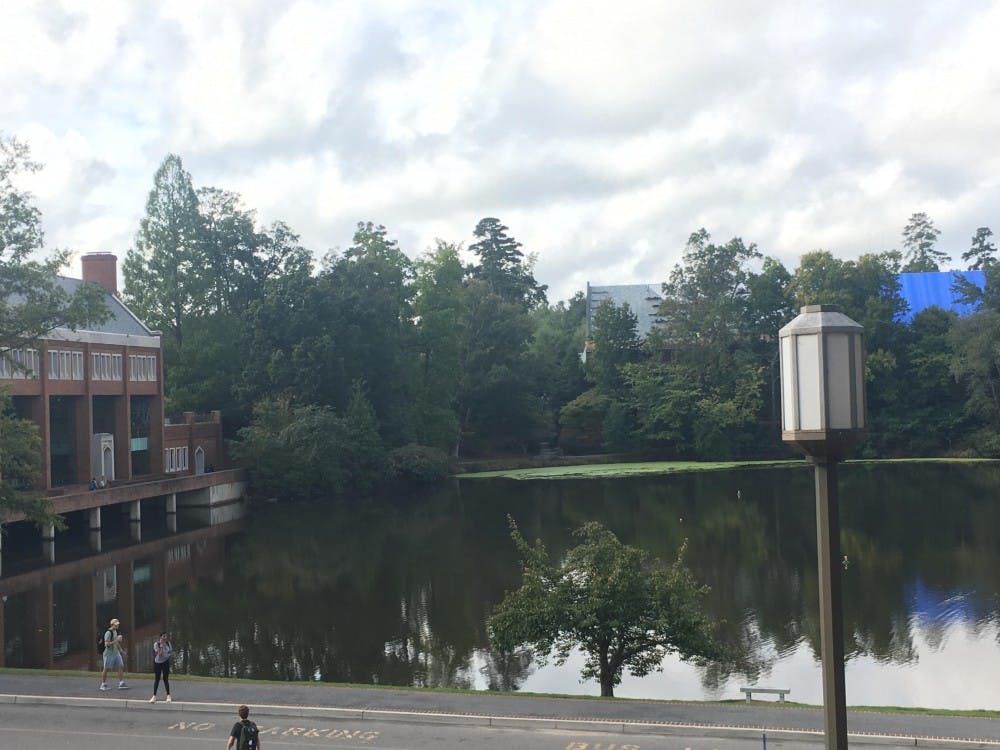A floating green substance called duckweed has recently given Westhampton Lake a vibrant, green appearance.
Additionally, new orange lights called “Goose Away” have been placed in the lake in order to encourage geese to find homes other than the lake, according to University Facilities and the Office for Sustainability.
Geese are harmful to lake because of their frequent defecation, which leads to high bacteria E. coli levels and makes the lake unsafe for swimming, said Allison Moyer, landscape manager for University Facilities.
Unlike the geese, the duckweed is not a point of concern for either the Office for Sustainability or University Facilities, Moyer said. The duckweed is beneficial to lakes and signals increased nutrition in the water. Moyer explains that despite it's strange green shade, duckweed has no negative consequences and does not harm the lake.
“The duckweed is a result of extra nutrients being in the lake,” Moyer said. “The good news is that the duckweed is doing a great job of using all of those extra nutrients. We have been taking water samples bi-weekly to monitor our nutrient levels.”
Although the duckweed is not harmful to the lake, some students have been concerned about the green coloration. Sophomore Sophie Weinberg said she was disappointed in the lake's appearance upon returning to school this year.
"The lake has always been a focal point of the school and is so unique to the campus," Weinberg said. "When I arrived back at school, I was shocked and upset with the unsavory green color of the lake. I think it's gross that it has been like that for the entirety of the semester."
The high levels of nutrients in the lake come as a result of heavy rainfall this year. With about two months left in the year, Central Virginia has already had seven inches more rainfall than the typical average rain for an entire year, Moyer said.
Rain enters the lake from an area called the watershed, which is the land that water flows across or through on its way to a stream, lake or wetland. The water then makes its way out into Gamble's Mill Creek and eventually into the James River, Moyer said.
The members of the Office for Sustainability are aware of the role Westhampton Lake plays within larger Virginia bodies of water such as the James River, said Rob Andrejewski, director of sustainability. By adding “Goose Away” lights, UR is working to decrease levels of E. coli in the water and in turn decrease the pollution our lake is sending into the James River.
“What ends up in the lake is not up to us,” Andrejewski said, “but we can decide how we manage it.”
Natural occurrences such as duckweed, as well as projects such as “Goose Away," illustrate ways that UR is working to manage and decrease pollutants in our lake in order to decrease pollutants in the rest of Virginia’s water sources, Andrejewski said.
Enjoy what you're reading?
Signup for our newsletter
The water in the lake runs eventually into the Chesapeake Bay, Andrejewski said. Especially in years of heavy rainfall when the water in our lake is constantly moving and flowing into larger bodies of water, it is of vital importance to maintain its health, Andrejewski said.
Contact news writer Heather Neiman at heather.neiman@richmond.edu.
Support independent student media
You can make a tax-deductible donation by clicking the button below, which takes you to our secure PayPal account. The page is set up to receive contributions in whatever amount you designate. We look forward to using the money we raise to further our mission of providing honest and accurate information to students, faculty, staff, alumni and others in the general public.
Donate Now



